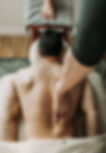What Is Ashiatsu?
- Jessica King, LMT @ Beaverton Advanced Therapeutics
- Oct 12
- 2 min read

The Massage That Uses Feet Instead of Hands
If you’ve ever heard someone say their massage therapist walked on them, they were probably talking about Ashiatsu—a unique, deeply therapeutic style of massage that uses the therapist’s feet instead of their hands. Sounds intense? It’s actually one of the most relaxing and effective forms of deep massage you can experience.
What Exactly Is Ashiatsu?
The word Ashiatsu comes from Japanese: ashi means “foot” and atsu means “pressure.” During an Ashiatsu session, the therapist uses their feet to deliver slow, broad, gliding strokes, applying consistent pressure that melts tension from muscles and fascia.
Overhead bars are used for balance and control, so every movement is smooth, intentional, and perfectly modulated. It’s not about walking on someone—it’s about using the broad, strong surface of the feet to create deep, even compression across the body.
Why People Love It
Ashiatsu is often described as deep tissue without the discomfort. Because the pressure is spread across a larger surface, it can reach the deeper muscle layers without the sharp or pokey feeling that sometimes comes with elbows and thumbs.
Clients often notice:
Profound relief in chronic upper and lower back tension
Improved mobility and posture
Decreased muscle soreness and stiffness
A deep sense of relaxation that lasts long after the session
It’s especially helpful for people who prefer firm pressure, athletes with dense muscle tissue, or anyone dealing with stubborn knots that never seem to release.
What It Feels Like
Most people are surprised by how gentle it feels. Instead of the focused dig of a thumb or elbow, Ashiatsu feels like long, flowing waves of pressure—steady, smooth, and grounding. Many describe it as being “hugged by gravity.”
Is Ashiatsu Safe?
Absolutely. When performed by a trained therapist, Ashiatsu is safe, controlled, and deeply therapeutic. I use overhead bars for balance, check in throughout your session, and tailor the pressure to your comfort level.
That said, Ashiatsu isn’t recommended for everyone—people with certain health conditions (like osteoporosis, pregnancy, or vascular issues) may need a different approach. I always take time to review your health history before deciding if it’s right for you.
Why I Love Practicing Ashiatsu
As a therapist, Ashiatsu allows me to blend the fluid, calming flow of Swedish massage with the grounded, restorative techniques of Tuina, creating a session that feels both nurturing and powerful. It’s a way to deliver deep relief without forcing the tissue—and it helps my clients reconnect with their bodies in a truly balanced way.
If you’ve been craving a massage that’s deep, relaxing, and different from anything you’ve tried before, Ashiatsu might be your new favorite.
.jpg)


